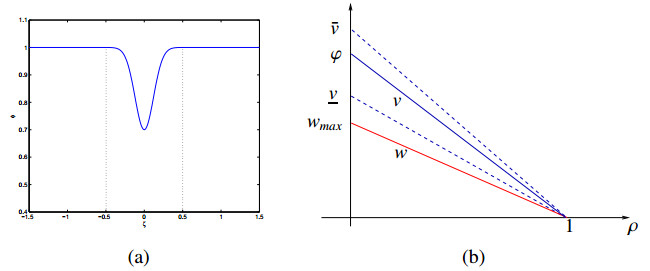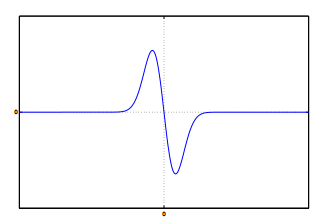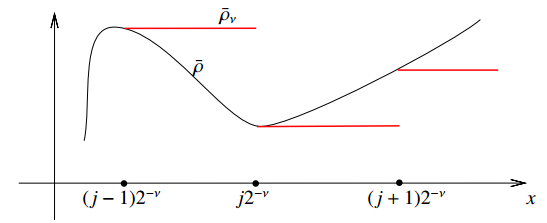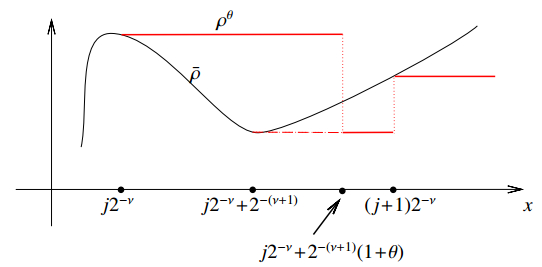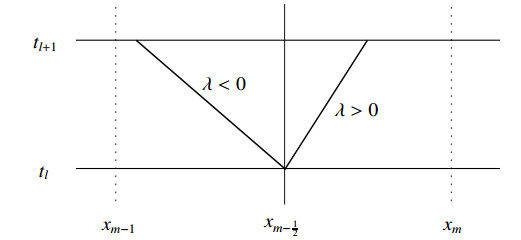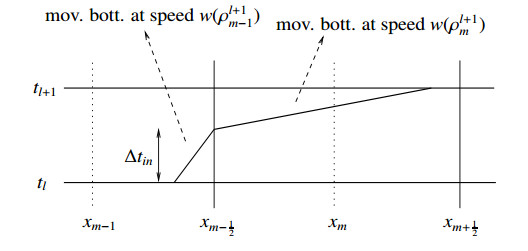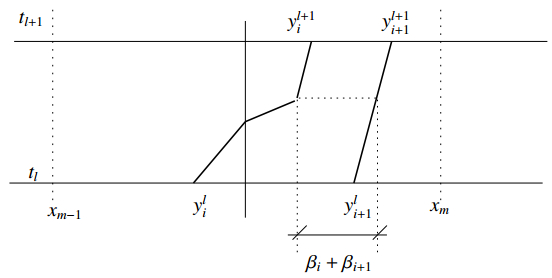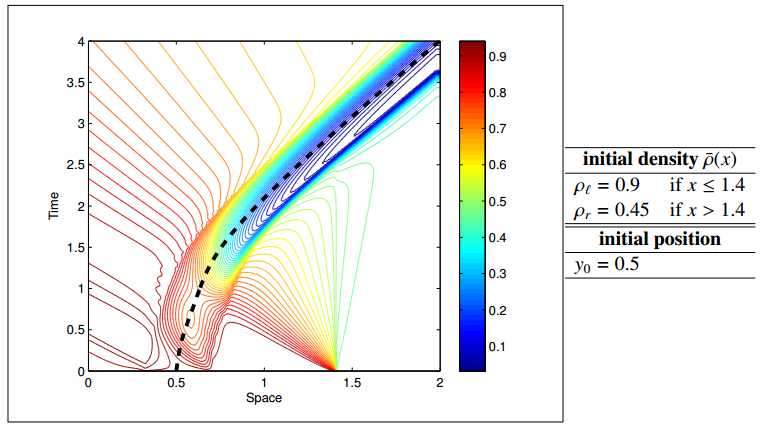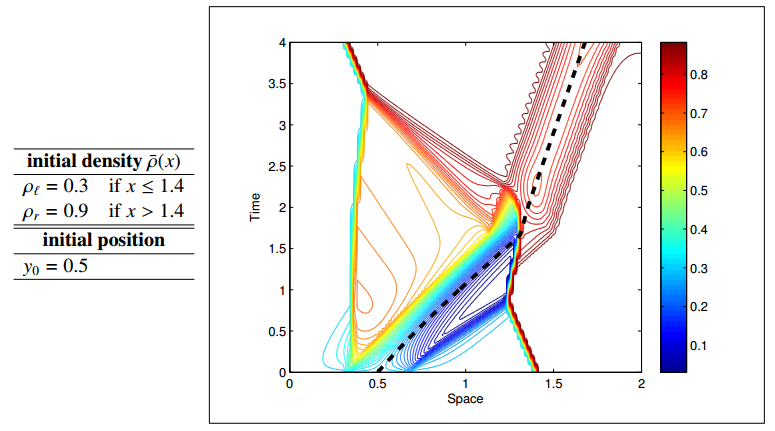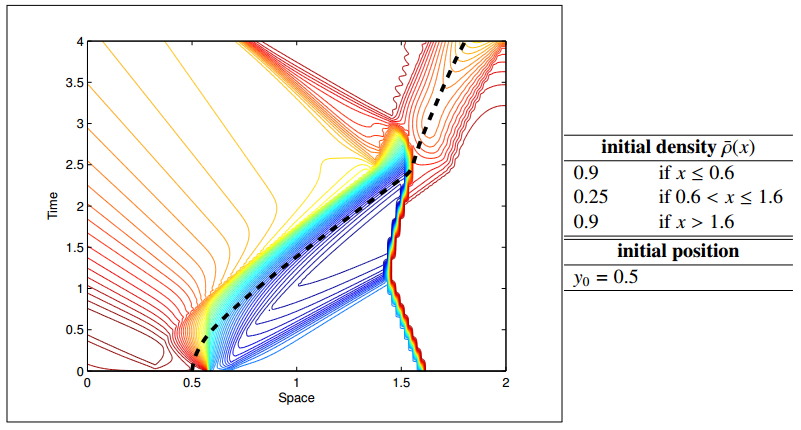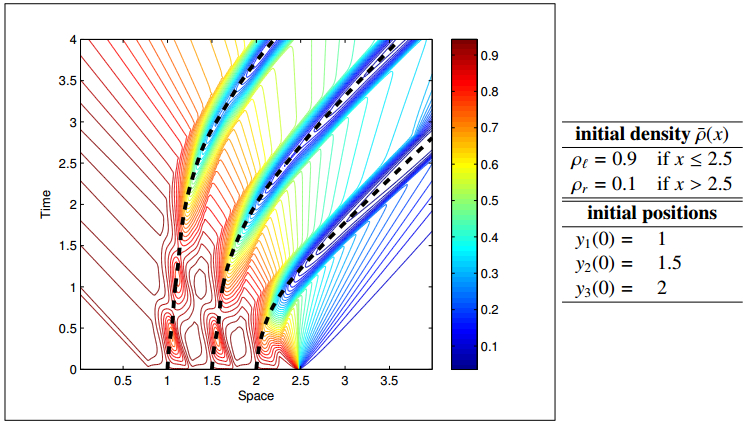In this paper we propose two numerical algorithms to solve a coupled PDE-ODE system which models a slow vehicle (bottleneck) moving on a road together with other cars. The resulting system is fully coupled because the dynamics of the slow vehicle depends on the density of cars and, at the same time, it causes a capacity drop in the road, thus limiting the car flux. The first algorithm, based on the Wave Front Tracking method, is suitable for theoretical investigations and convergence results. The second one, based on the Godunov scheme, is used for numerical simulations. The case of multiple bottlenecks is also investigated.
1.
Introduction
In most developing countries, oil palm is considered the most productive vegetable oil crop per unit area and contributes to economic growth mostly in developing countries [1,2]. Oil palm is the second most significant tree crop in Ghana economy after cocoa however, it is considered to be the leading cash crop in the rural economy in the forest belt of Ghana [3]. In 2010, Ghana Ministry of Food and Agriculture (MoFA), stated the total estimated area of oil palm in Ghana as 330,000/ha [4]. The product obtained from palm oil is known as the palm fruit. The palm fruit is processed into palm oil, palm kernel oil and palm cake oil whilst the crude palm oil is further processed into cooking oil, margarine, cosmetics, soaps and detergents. According to Ofosu-Budu and Sarpong [3], palm oil is noted to be the largest natural source of Vitamin E which is essential as well as dietary magnesium. Oil palm utilizes a high amount of nutrients from the soil for their optimum growth and development. This results in excessive removal of nutrients from the soil leading to a decline in soil fertility. Several studies show that the availability and use of inorganic and organic fertilizer have been low especially in large plantation farms. As a result, the decline in soil fertility in oil palm plantations is widespread [5,6]. Ofosu-Budu and Sarpong [3], emphasized inadequate demand-driven research especially in soil nutrient management is the major challenge to the local industry. Farmers in Mpohor district in the western region of Ghana have complained immensely of small fruit bunch of their oil palm despite the application of fertilizers, but in oil palm plantation, nutrient management is the key to higher fruit bunch of crops. Several studies have shown that N, P, K and Mg are the major soil nutrients required by oil palm for optimum vegetative growth and higher yield of fruit bunch. Joseph et al. [7] initiated research on the assessment of soil fertility status for cassava cultivation in some areas of Kogi east Agro-ecological zone of Kogi state and concluded that the potential yield of cassava depends on the soil quality indicators. In Ghana, Arthur et al. [8], did an assessment of soil fertility status in cocoa farms around the Ankasa National Park in the Jomoro District of the Western Region of Ghana Many kinds of research have been done on soil fertility status globally on various crops, particularly Ghana, but unfortunately, in the Mpohor district in the Western Region of Ghana none of this research has been conducted. It is, therefore, no surprise that farmers are complaining of the low yield of the oil palm in the district. Therefore the main objective of this study was to evaluate the fertility status of oil palm plantations in the Mpohor district in the Western Region of Ghana. The main hypothesis being tested is that the low oil palm yield recorded among farmers in Mpohor district is due to the low fertility of the soil. The results will guide us to advise farmers in the study area regarding types of fertilizer, rate of fertilizer application and soil fertility management strategy.
2.
Materials and methods
2.1. Study area
The study was carried out in the two farming communities, Odumase (A) and Edum Banso (B) in the Mpohor district in the Western Region of Ghana (Figure 1).
The annual rainfall in the area is around 1400 mm, with a bimodal rainfall pattern. The major season normally begins in February; reaches its peak in June and drops sharply in August. The minor season starts in September with the lowest occurring in December and January. Mean monthly temperatures remain high throughout the year and only fall to around 26℃ in August. February and March are the hottest months recording nearly 40℃. An absolute minimum temperature of 21℃ is usually recorded in January with an absolute maximum temperature of about 40℃ recorded in February.
2.2. Soil sampling
Two farming communities namely Odumase and Edum Banso were selected for soil sampling. Farmers in Odumase (A) were sufficient with the yield obtained from the oil palm plantation whiles Farmers in Edum Banso (B) always complained of their low yield from their farms. Hence Odumase (A) was used as a reference to compare to Edum Banso (B). The Edum Banso (B) community was selected because of the high complaint of low yield of oil palm by the farmers. According to the farmers in the Odumase community, they applied organic manure and 10-20-20 N-P-K during the transplanting stage and at the fruiting stage, they applied potassium and phosphorus from muriate of potash and dia ammonium phosphorus, respectively. However, farmers in the Edum Banso (B) applied 17-17-17, N-P-K once in a while. The majority of the farms selected for the study were previously used for cassava and plantain cultivation. Twenty-five (25) soil samples were collected in between trunks each from the communities at the depth of 0–20 cm with a diagonal pattern using soil augur. This was done in 2018 when the farmers were about to harvest the fruits for palm oil production and were sampled within 48 hours. The samples were placed in polythene bags, labeled and transported to the CSIR-Soil Research Institute laboratory for analysis. All soil samples were then air-dried to constant weight to avoid microbial degradation [9]. They were made lump-free by gently grinding repeatedly using a pulverizing machine and passed through a 2 mm plastic sieve before analysis. Samples were subjected to laboratory analysis for the major soil nutrients and the results obtained are presented below.
2.3. Soil physicochemical properties analysis
Soil pH was measured in the soil to water ratio of 1:2.5 soil: water (w/v) suspension [10]. Total nitrogen was measured by the modified Macro-Kjeldahl method [11]. Available phosphorus was extracted with Bray 1 solution and measured on a spectrophotometer [12]. Organic carbon was determined using the method of Nelson & Sommers [13] Exchangeable bases were extracted with 1.0M ammonium acetate solution. Sodium and potassium contents in the extract were determined using Atomic Absorption Spectrophotometer (AAS), while calcium and magnesium were determined by titration. The method of Thomas [14], was used for the determination of exchangeable acidity. Effective cation exchange capacity (ECEC) was then calculated as the sum of exchangeable cations (K, Ca, Mg, and Na) and exchangeable acidity (Al + H). Particle size analysis was done using the pipette method [15].
2.4. Nutrient availability indexation
To assess the nutrient availability status of the soil in the study area, organic carbon, available P, exchangeable K, calcium, magnesium and total nitrogen were calculated based on the specific rating chart (Table 1) and the nutrient index in soils was calculated using the method adopted by Ravikumar and Somashekar [16] (Table 2); Nutrient index (N.I.) = (L × 1 + NM × 2 + NH × 3) / TNS, Where L = Number of samples in the low category; M = Number of the sample in the medium category; H = Number of the sample in High category; TNS = Total number of samples. The nutrient index is used to predict the sufficiency of each soil quality indicators in fertile soil using soil test results obtained from the laboratory.
2.5. Data analysis
Descriptive statistics such as means, standard deviations, standard error, ranges and coefficient of variation for each physicochemical parameter of the soil were calculated.
3.
Results and discussion
The results of the soil fertility assessment are present in Tables 3 and 4 while the nutrient index is presented in Table 5.
3.1. Soil texture
The relative proportions of sand, silt and clay in a particular type of soil determine its soil class, textural class, textural grade, and texture. Soil productivity and sustainability depend on soil texture which has a direct influence on crop productivity. The properties of soil texture are dynamic. This means it changes depending on weathering rate and the initial mineralogy of the parent material or the deposition of material from streams, runoff, and erosion [17]. Soil texture influences soil quality indices. There wasn’t much difference that exists among the soil in the two separate locations. For site A, the % sand of soil samples ranged from 46 to 86% with the mean value of 60.2% and that of % silt were 8 to 26% with a mean of 25.8% while the range of % clay was 2 to 38% with a mean of 25.42%. The location B soil recorded a mean percentage of 67.2, 17.8 and 15 respectively (Table 3). The higher % portion of sand was recorded in soil samples from Edum Banso (B) will have a direct influence on soil fertility and crop productivity in the study area due to their low nutrient and water retention capacity [18,19], hence contributing to the low yield of palm fruit obtained by farmers. The application of organic amendments such as manure and compost will improve the physicochemical properties of such soil.
3.2. Soil pH
Soil pH is an important chemical parameter of soil because it has direct effects on nutrient availability [20]. The pH of the soil samples analyzed varied from 4.44 to 6.56 with a mean value of 5.41. The pH of the soil samples analyzed varied from 4.29 to 5.42 with a mean value of 5.45 for A, while B recorded a mean of 5.05. The low acid recorded by location A was due to the application of manure and compost be done regularly by the farmers. The pH recorded for the study area was weakly acidic which plays a significant role in the metal bioavailability to plant, toxicity, microbial growth and leaching capacity of soil to surrounding areas [21]The factors that may influence the low pH of soil samples from Edum Banso are prolonged use of inorganic fertilizer, acidic rainfall and decomposition of organic matter. According to Jusop [22], palm trees are tolerant of acid soils, however, they grow well in the pH range between 4.3 to 6.5. Oil palm can tolerate the level of acidity of the soil, therefore, liming will not be needed (Table 4).
3.3. Organic matter and organic carbon
Organic matter is a reservoir of nutrients that can be released into the soil. It improves soil structure and plays an important role in carbon sequestration. Higher organic matter results in higher organic carbon in the soil. Organic matter results from the decomposition of plants and animals which is an important source of plant essential nutrients. Organic matter increases the physicochemical properties of the soil hence, increasing soil productivity. Johnston, [23], stated that organic matter aid in availability of plant nutrient, improve the soil structure, water infiltration and retention, feeds soil micro-flora and fauna, and the retention and cycling of applied fertilizer. Site A and site B recorded organic matter means the value of 2.31% and 1.38% respectively. Soil samples from Edum Banso (B) farming community recorded low organic matter due to poor soil management practices by the farmers. Low organic matter recorded for soil samples from Edum Banso (B) indicates low decomposition waste plants, animals, and microorganisms in the soil hence resulting in low soil carbon (0.71%). However, farmers in odumasi (A) community have been applying manure as well as using their pruned palm front as mulching materials hence leading to the high organic matter and organic carbon recorded (1.23 %) recorded. The organic carbon recorded for soil samples from Edum Banso (B) falls below the OC critical threshold at 1.2 % for oil palm trees [24]. Low organic matter can be corrected by mulching the farm with the pruned palm front. The pruned palm front should be cut into smaller pieces for mulching to facilitate decomposition (Table 4).
3.4. Total nitrogen
Plants require a relatively large amount of nitrogen for their development. This explains why most of the plant growth is restricted by a deficiency of nitrogen than any other nutrient. Soil from locations [A and B], recorded nitrogen mean values of 0.16 and 0.09% respectively. The N recorded for soil samples from Odumase (A) and Edum Banso (B) were above and below the N critical threshold of (0.15%) for the oil palm tree, respectively [24]. The higher nitrogen recorded was due to the high OC recorded since there is a direct relationship that exists between organic matter and nitrogen. The higher the organic matter content in the soil, the higher N content in the soil. However, location B needs to improve its low N content to meet the N requirement for the Oil Palm tree. Application of nitrogenous base fertilizer and organic resources (compost, manure) is key to increasing the N content of the soil for soils from Edum Banso (B) (Table 4).
3.5. Available phosphorus
The available phosphorus ranged from 0.32 to 19.29 mg kg-1 with a mean value of 3.31 mg kg-1 for soil samples from Odumase (A) while soil from Edum Banso (B) recorded phosphorus mean value of 7.6 mg kg-1. According to Goh et al. [26], available P content less than 25 mg kg-1 is below the phosphorus threshold for oil palm trees. However, soil from Odumase (A) recorded high available phosphorus than Edum Banso (B). The low available phosphorus recorded by the soil from Edum Banso (B) was due to the strong acid nature of the soils. Application of phosphorus fertilizers, liming and P solubilizing microorganisms will be necessary to increase available phosphorus in the soil (Table 4).
3.6. Exchangeable bases (Ca2+, Mg2+, K+, and Na+)
Except for nitrogen, potassium is present in plants in larger quantities than any mineral derived from the soil. Potassium is responsible for the metabolism in the movement of the stomata resulting in the activation of cell division [27]. The potassium content of soil of the particular region is related to parent material and the degree of weathering. There were no significant differences among the soil samples from Odumase (A) and soil from Edum Banso (B). Both locations A and B recorded available potassium of 0.22 and 0.21 cmol kg-1, respectively. The potassium content recorded for two locations [A and B] was above the critical K threshold of 20 cmol kg-1 for oil palm [24]. However, farmers may be advised to either maintain or increase the potassium fertilizer rate to prevent the depletion of potassium in the soil. According to Ogeh and Osiomwan [28], the calcium content of the soil differs at various points depending on directional changes and the distance from nearby samples. The result from the present study showed that site A recorded higher variability (85.6%) as compared to site B (30.60%) for Ca content in the samples analyzed (Table 5). The analysis showed that calcium content for both site ranged from 0.53 to 4.05 cmol kg-1 while site A obtained a range from 0.64 to 4.05 cmol kg-1 and site B also obtained a range from 0.53 to 1.28 cmol kg-1. The mean value observed for sites A and B were 1.22 cmol kg-1 and 0.70 cmol kg-1 respectively. The calcium content recorded for both Odumase and Edum Banso were above the critical level of Ca for oil palm tree [29]. However, soil samples from Edum Banso recorded high Ca content due to its high base saturation recorded. The Mg recorded for the two sites [A and B] were very high than the proposed critical Mg threshold (0.30 cmol kg-1) for oil palm. Therefore, the application of magnesium source fertilizer is usually not required unless to correct for nutrient imbalance [24]. According to Cha-Um et al. [30], the salt-affected soil problem is a member of abiotic stresses, which are a major problem worldwide. They further stated that it is a soil composing of various salts, which are quickly dissolved in water to produce toxic ions, especially sodium ions (Na+). Sodium-ion (Na+) is well established for negatively affecting plant growth and development before plant cell death [31,32,33]. The sodium (Na) content recorded for both site A and site B had a mean value of 0.75 and 0.64 cmol kg-1 respectively. The sodium (Na) content recorded had a low mean value of 0.04 cmol kg-1. The level of Sodium (Na+) accumulated in the soils of the oil palm fields depends on the degree of salt treatments in terms of EC (dS m-1)
[33] (Table 4).
3.7. Base saturation and Cation Exchange Capacity (CEC)
Base saturation (BS) is defined as the percentage of CEC occupied by Ca2+, Mg2+, K+, and Na+. Base saturation (BS) content of soil samples from Odumasi (A) recorded a high mean value of 60.99 cmol kg-1 compared to soil samples from Edum Banso (B) (52.72) cmol kg-1. The availability of Ca2+, Mg2+, K+, and Na+ depends on the high BS. Hence the low BS recorded by Edum Banso (B) was due to the low availability of Ca2+, Mg2+, K+, and Na+ in the soils. The content of Cation Exchange Capacity (CEC) recorded by the two sites (A and B) was 3.03 and 2.28 cmol kg-1 respectively. Farmer’s application of manure in site A influenced the high CEC in site A since Cation Exchange Capacity is influenced by soil organic matter (SOM) and high clay particles especially in humic form, contributed to soil colloids having charges which can hold cations [34].
Soil samples from Edum Banso recorded a low content of nutrient availability index of TN, OM, Ca, Mg, Na, P and moderate content of K whiles soil samples from Odumase recorded a moderate level of TN, P, OM and ECEC and this was due to the application of the manure being done by the farmers in the region. However, a low Ca, Mg and Na were recorded for the nutrient availability index.
4.
Conclusion
The study revealed that the nutrients content of both sites was different. Soil samples from Odumase (A) recorded a high OM, OC, TN, P, Ca which are above their critical value for oil palm tree whiles soil samples recorded a low nutrient of OM, OC, TN, P and Ca. The nutrient availability index indicated a low nutrient availability of TN, OM, P and Mg. Hence the low palm yield being recorded by farmers in Edum Banso (B) is due to the low nutrient content of the soils. Hence proper nutrient management approaches such as the application of inorganic fertilizer should be adopted especially for nutrients that are deficient and low.
Acknowledgments
The authors thank the African Center of Excellence in Agroecology and Livelihood System for their financial support and encouragement.
Conflict of interest
The authors declare that they have no competing interest.
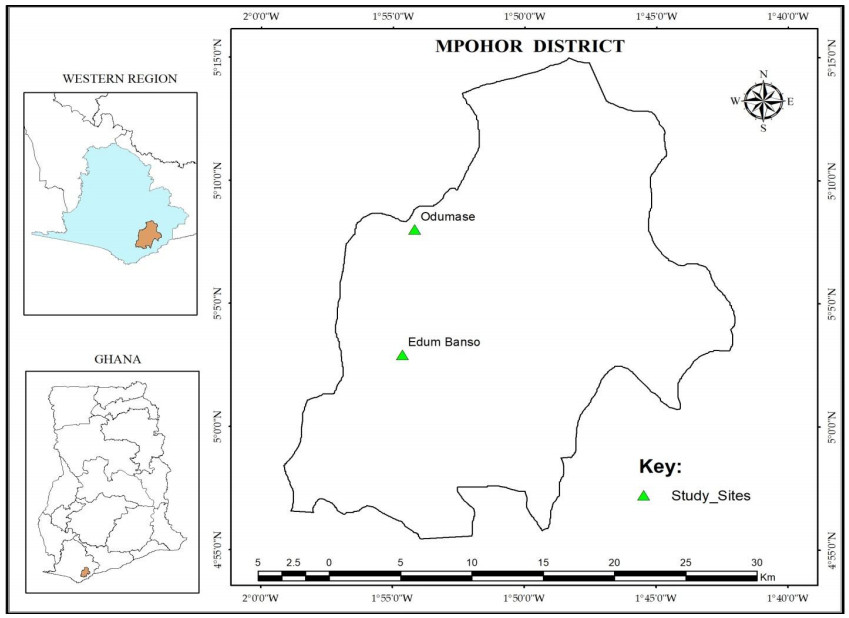









 DownLoad:
DownLoad:


